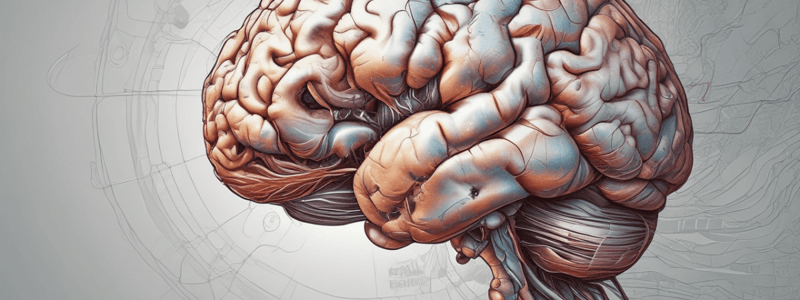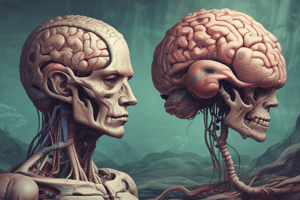Podcast
Questions and Answers
What is the primary function of the superior colliculi?
What is the primary function of the superior colliculi?
- Visual reflexes (correct)
- Motor control
- Cognitive processing
- Auditory processing
Where do the trochlear nerves emerge from?
Where do the trochlear nerves emerge from?
- Midline below the inferior colliculi (correct)
- Lateral aspect of the midbrain
- Posterior aspect of the midbrain
- Anterior aspect of the midbrain
What is the name of the depression in the midline of the anterior aspect of the midbrain?
What is the name of the depression in the midline of the anterior aspect of the midbrain?
- Crus cerebri
- Posterior perforated substance
- Cavernous sinus
- Interpeduncular fossa (correct)
What is the term for the region where many small blood vessels perforate the floor of the interpeduncular fossa?
What is the term for the region where many small blood vessels perforate the floor of the interpeduncular fossa?
What is the destination of the superior brachium?
What is the destination of the superior brachium?
What nerve emerges from a groove on the medial side of the crus cerebri?
What nerve emerges from a groove on the medial side of the crus cerebri?
What is the connection point of the inferior brachium?
What is the connection point of the inferior brachium?
In which direction do the superior and inferior brachia ascend?
In which direction do the superior and inferior brachia ascend?
What is the function of the Edinger-Westphal nucleus?
What is the function of the Edinger-Westphal nucleus?
Which nucleus contains primary sensory neurons that innervate the muscle spindle of the masticatory and other muscles in the oro-facial region?
Which nucleus contains primary sensory neurons that innervate the muscle spindle of the masticatory and other muscles in the oro-facial region?
What is the function of the red nucleus in terms of movement?
What is the function of the red nucleus in terms of movement?
What is the source of the reddish hue of the red nucleus?
What is the source of the reddish hue of the red nucleus?
What is the dorsal part of the midbrain divided into?
What is the dorsal part of the midbrain divided into?
What is the function of the superior colliculus?
What is the function of the superior colliculus?
What is the origin of the rubrospinal tract and rubroolivary tracts?
What is the origin of the rubrospinal tract and rubroolivary tracts?
What is the passage connecting the third and fourth ventricles?
What is the passage connecting the third and fourth ventricles?
What is the ventral part of the cerebral peduncle?
What is the ventral part of the cerebral peduncle?
What is the destination of the efferent fibers from the red nucleus?
What is the destination of the efferent fibers from the red nucleus?
Where is the oculomotor nucleus located?
Where is the oculomotor nucleus located?
What is the location of the red nucleus in relation to the substantia nigra?
What is the location of the red nucleus in relation to the substantia nigra?
What is the function of the corticospinal and corticonuclear tracts?
What is the function of the corticospinal and corticonuclear tracts?
How many transverse sections are made in the midbrain?
How many transverse sections are made in the midbrain?
What is the function of the substantia nigra?
What is the function of the substantia nigra?
What is the decussation of the rubrospinal tract?
What is the decussation of the rubrospinal tract?
What type of sensations are carried by the spinal lemniscus?
What type of sensations are carried by the spinal lemniscus?
What is the primary function of the substantia nigra?
What is the primary function of the substantia nigra?
Which part of the crus cerebri contains the corticospinal and corticonuclear fibers?
Which part of the crus cerebri contains the corticospinal and corticonuclear fibers?
What is the name of the nucleus that carries general sensations from the opposite side of the head and face?
What is the name of the nucleus that carries general sensations from the opposite side of the head and face?
What is the characteristic of the neurons in the substantia nigra?
What is the characteristic of the neurons in the substantia nigra?
What is the result of damage to the substantia nigra?
What is the result of damage to the substantia nigra?
What is the structure that separates the crus cerebri from the tegmentum?
What is the structure that separates the crus cerebri from the tegmentum?
What is the function of the frontopontine fibers?
What is the function of the frontopontine fibers?
Which of the following structures is connected to the lateral geniculate body by the superior brachium?
Which of the following structures is connected to the lateral geniculate body by the superior brachium?
Which of the following nerves emerges on the medial side of the crus cerebri in the interpeduncular fossa?
Which of the following nerves emerges on the medial side of the crus cerebri in the interpeduncular fossa?
What is the function of the tectospinal and tectobulbar tracts?
What is the function of the tectospinal and tectobulbar tracts?
Where is the pretectal nucleus located?
Where is the pretectal nucleus located?
What is the name of the nucleus that relays the afferent pathway for the light reflex?
What is the name of the nucleus that relays the afferent pathway for the light reflex?
Which of the following is NOT a structure seen at the level of the transverse section of the midbrain at the level of the inferior colliculi?
Which of the following is NOT a structure seen at the level of the transverse section of the midbrain at the level of the inferior colliculi?
What is the function of the parasympathetic nucleus of the oculomotor nerve (Edinger-Westphal nucleus)?
What is the function of the parasympathetic nucleus of the oculomotor nerve (Edinger-Westphal nucleus)?
Which of the following receives afferent fibers from the optic nerve, the visual cortex, and the spinotectal tract?
Which of the following receives afferent fibers from the optic nerve, the visual cortex, and the spinotectal tract?
Study Notes
Midbrain Structure
- Divided into dorsal and ventral parts at the level of the cerebral aqueduct
- Dorsal portion (tectum) includes 4 colliculi: 2 inferior and 2 superior
- Ventral portion (cerebral peduncles) consists of 2 thick nervous cords extending from the forebrain to the pons
Cerebral Peduncles
- Each peduncle divides into 3 parts:
- Midbrain tegmentum (dorsal part)
- Substantia nigra (pigmented grey matter)
- Crus cerebri (ventral part)
Cerebral Aqueduct
- Connects the third and fourth ventricles
- Lined by ependyma and surrounded by central gray matter
Transverse Sections of the Midbrain
- 2 transverse sections: upper level (level of superior colliculi) and lower level (level of inferior colliculi)
Upper Level (Level of Superior Colliculi)
- Structures seen at this level:
- Nuclei: oculomotor nucleus, Edinger-Westphal nucleus, mesencephalic nucleus of trigeminal nerve
- Superior colliculus
- Red nucleus
- Motor tracts: corticospinal and corticonuclear tracts
- Temporopontine, frontopontine, and medial longitudinal fasciculus
- Decussation of rubrospinal tract
- Sensory tracts: nuclei at the level of superior colliculi
Oculomotor Nucleus
- Situated in the central gray matter close to the median plane
- Contains somatic efferent fibers that control medial rectus, inferior rectus, superior rectus, inferior oblique, and striated muscle in the levator palpebrae superioris
- Connected to the lateral geniculate body by the superior brachium
- Receives afferent fibers from the optic nerve, visual cortex, and spinotectal tract
- Efferent fibers form the tectospinal and tectobulbar tracts
Lower Level (Level of Inferior Colliculi)
- Structures seen at this level:
- Nuclei: trochlear nucleus, mesencephalic nuclei of trigeminal nerve
- Inferior colliculus
- Motor tracts: corticospinal and corticonuclear tracts
- Temporopontine, frontopontine, and medial longitudinal fasciculus
- Sensory tracts: lateral, trigeminal, spinal, and medial lemnisci
Red Nucleus
- Situated in the tegmentum, at the level of the oculomotor nervenucleus
- Functions: walking coordination, preservation of muscular tone, receives and relays input from the cerebral cortex and cerebellum
- Origin of the rubrospinal and rubroolivary tracts
Substantia Nigra
- Large motor nucleus situated between the tegmentum and the crus cerebri
- Composed of medium-size multipolar neurons with melanin pigment inclusion granules
- Concerned with muscle tone and connected to the cerebral cortex, spinal cord, hypothalamus, and basal nuclei
Cranial Nerve Nuclei
- Trochlear nucleus: situated in the midline below the inferior colliculi
- Oculomotor nucleus: situated in the central gray matter close to the median plane
- Edinger-Westphal nucleus: supplies preganglionic parasympathetic fibers to the eye, constricting the pupil, accommodating the lens, and convergence of the eyes
Studying That Suits You
Use AI to generate personalized quizzes and flashcards to suit your learning preferences.
Related Documents
Description
Test your knowledge of the midbrain, including its structures such as the superior and inferior colliculi, brachia, and their connections. Learn about the roles of these components in visual and auditory reflexes.




